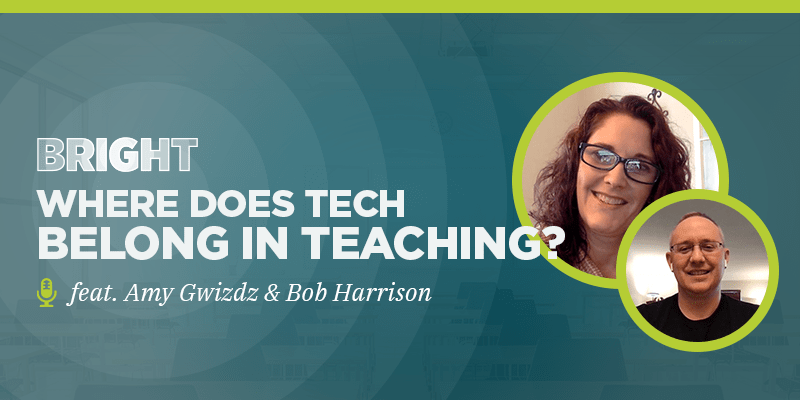Listen to the BRIGHT podcast
The role of technology in our classrooms has never been so prominent, nor so strained as during the COVID-19 pandemic.
For many teachers, working from behind a screen was an incredibly difficult transition. They reported feeling intense emotional sadness over the physical separation from students, with some even going so far as to describe feeling as they moved from “teaching in 3D” to “teaching in 2D.”
Two instructional technology coaches for Dearborn Public Schools — Amy Gwizdz and Bob Harrison — say that they’re feeling the “Zoom fatigue” themselves and are sensitive to the impact this has had on teachers everywhere.
However, they also fear that the compounding effects of this phenomenon might lead to resistance against using technology in the classroom.
“I personally will be very happy the day I don’t have to get on Zoom, so I don’t blame anybody,” Gwizdz says. “But it is a double edged sword because there’s a risk that people may end up resenting technology due to all the time they’ve spent in front of their computer. When we go back face-to-face, my fear is that people are going to put their Chromebooks on the cart and walk away from it.”
Her learning partner offers a slightly different perspective:
“I do think there’s also another possibility,” Harrison shares. “I think a lot of teachers have really seen the benefit of using technology in education, and I’m hopeful that when we do go back face-to-face that there will be a lot of teachers that are doing things with technology who weren’t using technology before.”
They’re hopeful we can emerge from this crisis not adverse to technology in the classroom, but simply more intentional with it.
The classrooms of the future
What role should technology continue to play in our classrooms once the reign of COVID-19 finally ends?
According to Gwizdz and Harrison, the future lies in using technology to further student-centered learning.
“Student-centered learning operates around the idea of giving ‘voice’ and ‘choice’ to students, so they’re driving their own instruction,” says Gwizdz. “It’s not a teacher-centered classroom where the teachers are making all the decisions. By giving students the opportunity to express their choices, you’re going to actively increase their motivation and their engagement in your lessons.”
See also: “What exactly IS student-centered learning?”
At the beginning, this approach can seem daunting for teachers, but after the initial investment, it can become more self-sustaining as students take more agency over their learning. As Gwizdz explains, “We like to say, “Why should the teachers have to do all the work? Let’s let the students do some of the work.’”
When leveraged strategically, technology should be used to take work off of teachers’ plates and help them focus on the things that only they can do.
“Having technology as another resource in the classroom is something that should help teachers take some responsibilities off of their plate,” she says. “When I was in the classroom, I used several different programs for either remediation or for enrichment. If I had students who needed extra help, there were videos or demonstrations that they could do online. If I had students who were ahead of schedule and needed some enrichment, there were other things that they could do online.”
“For some students,” Gwizdz says, “technology is their mode of transportation for knowledge. It’s how they express themselves.”

“Having technology as another resource in the classroom is something that should help teachers take some responsibilities off of their plate.”
Technology solves problems… but not all problems.
As instructional technology coaches for Dearborn Public Schools — Michigan’s third largest school district with 1500 teachers and 34 separate school buildings — Gwizdz and Harrison say their role has shifted during the pandemic.
“The rubber really hit the road this year when everyone was forced to use digital tools,” says Harrison. “We’ve been slowly transitioning into trying to help people be intentional about the way that they use technology to make deliberate and well-informed choices about the tools that they use, how they use them, and when they use them.”
This intentionality works best when approached through the lens of an instructional problem. “Technology solves a problem,” he says. “What is the problem that you’re encountering? Is it appropriate to use technology to solve that problem?”
“We also try to have teachers start with the why,” adds Gwizdz. “Why is it that you are choosing to use this tool? What is the instructional strategy behind the tool? What is it you’re trying to get across to students? What do you want them to learn? And then we can talk about how we should get there.”
Just because technology can solve instructional problems, however, doesn’t mean it’s appropriate in every learning situation.
“I think one of the biggest epiphanies we’ve had as technology coaches,” Harrison explains, “is acknowledging that there are times in a classroom when technology is not the answer. And, in fact, making the deliberate and intentional choice to not use technology actually solves the problem in some cases, as opposed to trying to force you know, a technological tool into that aspect of the classroom.”
There’s a lot to unpack here, but the vision for learning that this instructional technology coach duo evoke is a powerful one. They envision a system where students have more agency over their own learning and teachers can leverage technology to focus their time and energy on what they do best.
To dive deeper into how technology can further student-centered learning, check out Gwizdz and Harrison’s podcast, ArchiTECHS of Learning.
It will take some time for us to recover from the lingering effects of the stress, isolation, and Zoom fatigue experienced during COVID-19, especially our state’s teachers, many of whom took on the near-overnight burden of reorganizing their professional lives to teach their students from behind a screen.
But as we look forward, there is reason to hope that some of the skills our educators have learned during this difficult time will help pave the path toward a brighter future.

